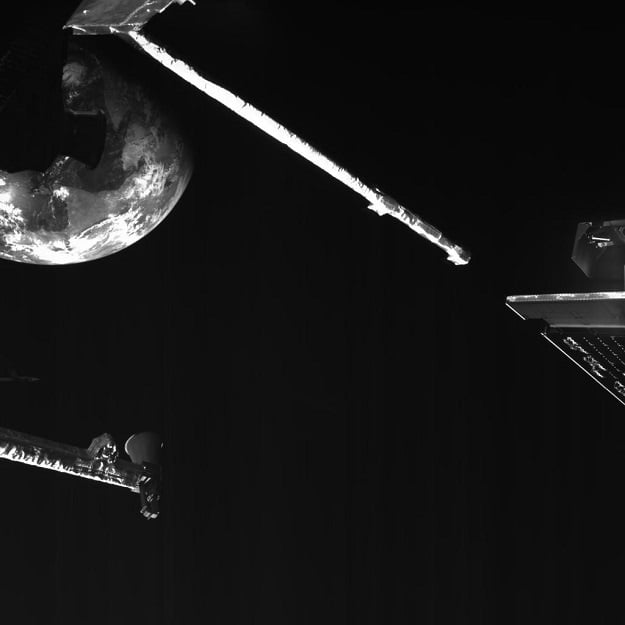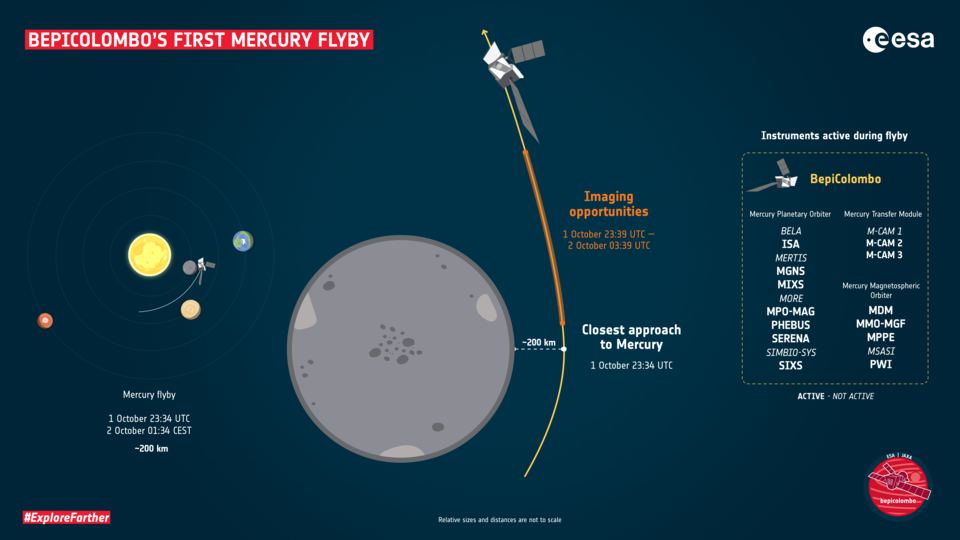BepiColombo made a quick visit to Venus in August and is on to its next rendezvous. On October 1st it'll perform a flyby of Mercury, the spacecraft's eventual destination. This visit is just a little flirtation—one of six—ahead of its eventual orbital link-up with Mercury in late 2025.
The quick visit will yield some scientific results, though, and they'll be just a taste of what's ahead in BepiColumbo's one-year mission to Mercury.
BepiColombo is on a bit of a tour of the inner regions of the Solar System on its way to Mercury. The complicated route full of flybys of Earth, Venus, and Mercury is the only way to get the spacecraft into orbit at Mercury. BepiColombo launched in October 2018 from Europe's Spaceport in French Guiana. Then it travelled through space for a year and a half before returning to Earth for a gravity-assist manoeuvre that directed it toward Venus.
Then came two consecutive flybys of Venus to reduce its perihelion to Mercury distance. Those are both in the past now and next come six consecutive flybys of Mercury, each one helping to lower the spacecraft's eventual relative velocity to only 1.84 km/s. After the flybys are complete, BepiColombo will perform four thrust arcs to lower its velocity some more. Only at that point will the spacecraft be in a position for Mercury's weak gravity to play its role in all this. On December 5, 2025, the spacecraft will enter orbit around Mercury without a traditional orbital insertion. Quite a feat.
This complicated route is necessary because Mercury's puny gravity is dwarfed by that of the Sun.
But before all that can happen it's going to give us its first taste of Mercury science by swooping past the planet at about 200 km (124 mi) altitude. What'll it find during that brief visit?
"We're really looking forward to seeing the first results from the measurements taken so close to Mercury's surface...It's a fantastic feeling!"Johannes Benkhoff, ESA's BepiColombo project scientist.
BepiColombo won't be in full-blown science mode during the flyby. That's because of the spacecraft design. The mission is a joint effort between the ESA and JAXA, the Japan Aerospace Exploration Agency. So the spacecraft is actually two orbiters in one: the ESA's Mercury Planetary Orbiter (MPO) and JAXA's Mercury Magnetospheric Orbiter (Mio) wedded to the Mercury Transfer Module (MTM.) The two orbiters will be separated once in orbit at Mercury, but during these flybys, they're together. Because of that, there's a limit to the data and images they can gather.
There'll be no high-resolution images because the main science camera is shielded by the MTM during cruise operations. But the three monitoring cameras (MCAM) will be operating. They're the cameras that have provided mission images of the flybys of Earth and Venus so far.
Unfortunately, BepiColombo will be arriving on the planet's nightside during the flyby, so it's not an ideal situation for capturing images. The three MCAMs will be operating from five minutes after the closest approach until four hours later. That means the closest image will be captured from about 1,000 km (620 mi.)
MCAM images show parts of the spacecraft itself due to their positioning on the MTM. The cameras capture black and white images at 1024x1024 and about 30 minutes after the closest approach images will start to come in. Expect a stream of them on Saturday morning in Central European Summer Time. Here on the west coast of North America, they'll start arriving at around 11:00 PM.
While MCAMs have their limitations, the images will still be interesting. The ESA says that we should be able to see large impact craters on Mercury's surface.
When it comes to BepiColombo's science instruments, it's a similar situation. Some of the science instruments on both orbiters will be able to operate, but there'll be limitations. The spacecraft will give us a little taste of what's to come when it takes a quick sample of Mercury's magnetic, particle, and plasma environment. After years of planning and space travel, the spacecraft is finally starting to study its target.
"We're really looking forward to seeing the first results from measurements taken so close to Mercury's surface," says Johannes Benkhoff, ESA's BepiColombo project scientist. "When I started working as project scientist on BepiColombo in January 2008, NASA's Messenger mission had its first flyby at Mercury. Now it's our turn. It's a fantastic feeling!"
It's somewhat remarkable that BepiColombo is only the third spacecraft to visit Mercury, even though the average distance between Mercury and Earth is about 77 million km (48 million mi.) We've sent spacecraft much further into the Solar System than that. For instance, Jupiter is an average of 715 million km (484 million mi) away—about ten times more distant—and we've sent two missions to the gas giant (Galileo and Juno.) Another five missions have included flybys of Jupiter.
Mercury is difficult to visit largely because of its proximity to the Sun. The Sun's gravity is a powerful force for any spacecraft to contend with, especially when compared with Mercury's weak gravity. Mercury, as its name implies, also orbits the Sun very quickly, so spacecraft intending to rendezvous with the planet must have a high velocity.
That's also what makes landing on Mercury so difficult. Typically, planetary exploration goes like this: flybys, an orbiter, a lander, then a rover on the surface. Will we one day land on Mercury?
A 2018 white paper looked at the issue in detail. The main challenges are the relative velocity involved and also the enormous launch energy. But the authors of the paper noted that launch vehicle capabilities have evolved and continue to evolve. Launch vehicles like NASA Space Launch System, SpaceX's Falcon Heavy, and the Ariane 6 mean that the challenges to reaching Mercury's surface should eventually be overcome.
The gold standard for a mission to Mercury's surface would be a sample return to Earth. That's likely well out of reach for while.
For now, we can look forward to all that BepiColombo will tell us about Mercury.
 Universe Today
Universe Today


